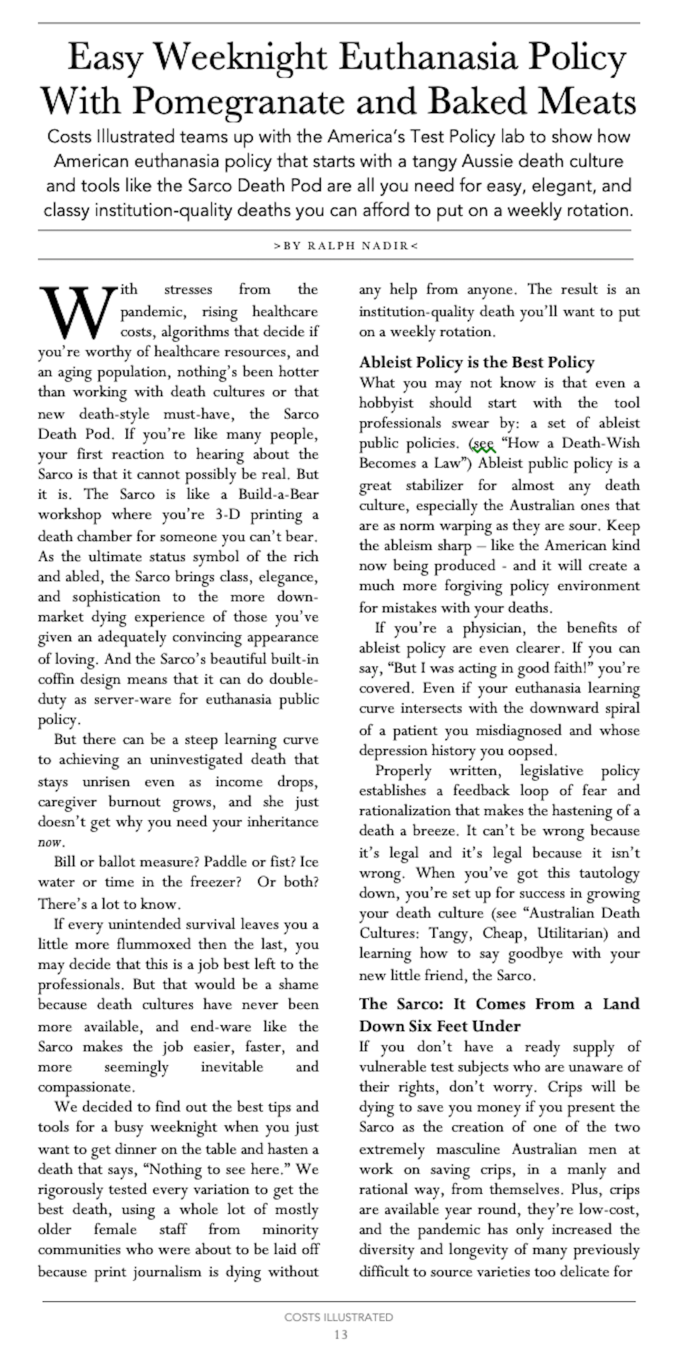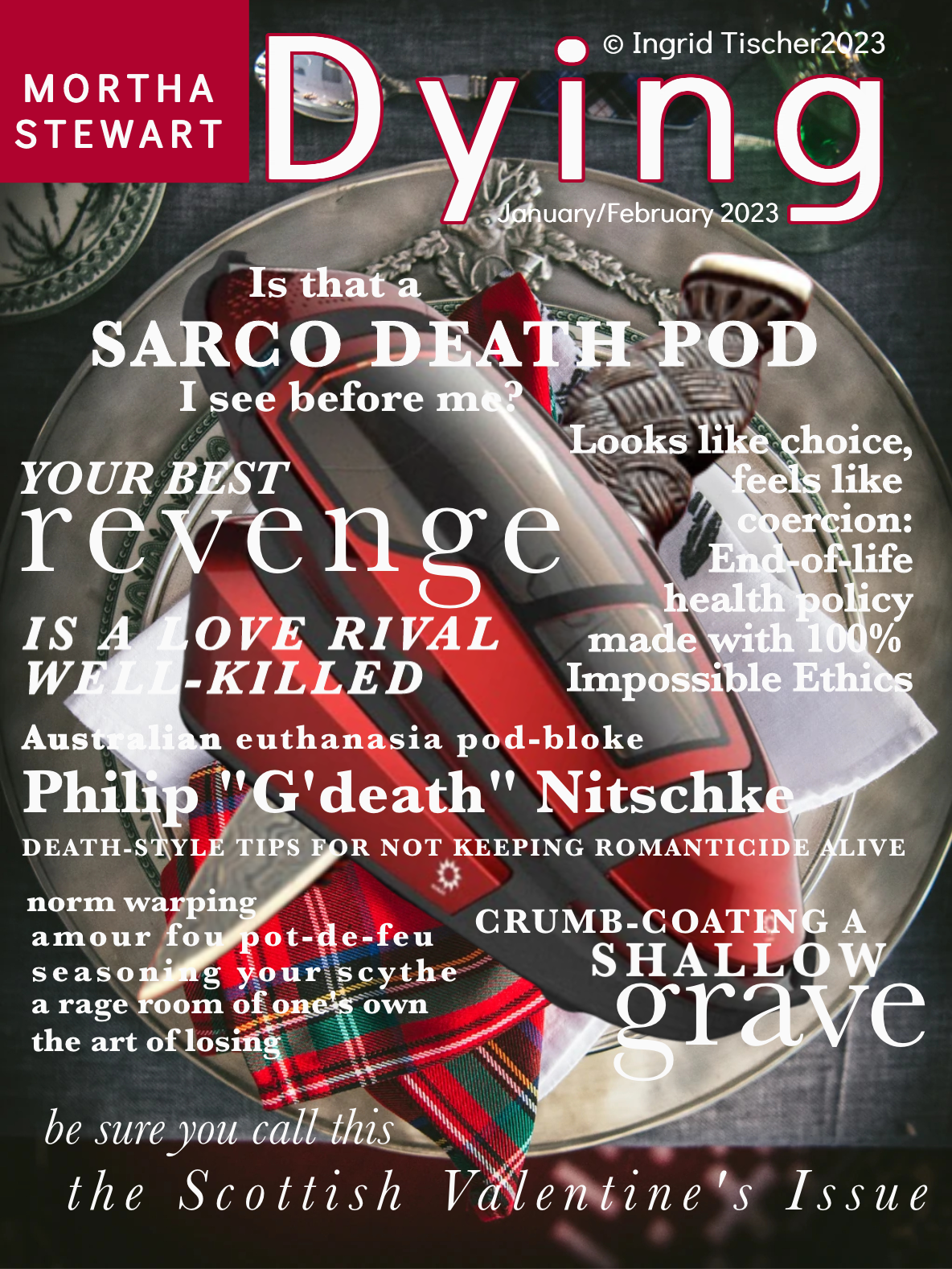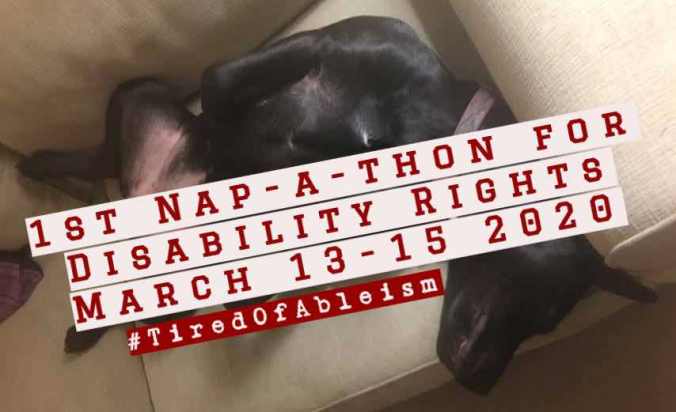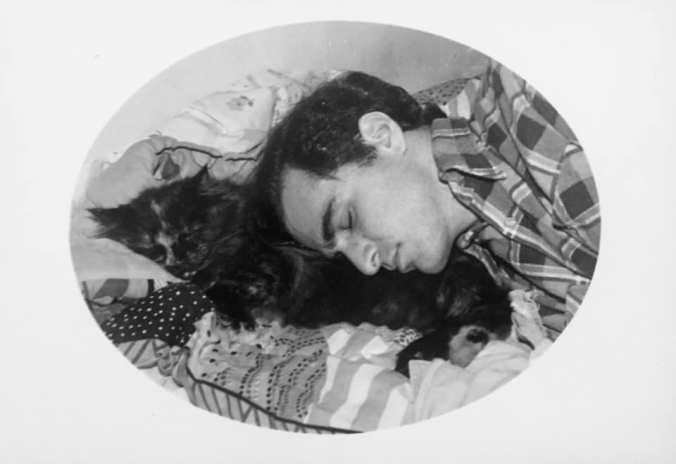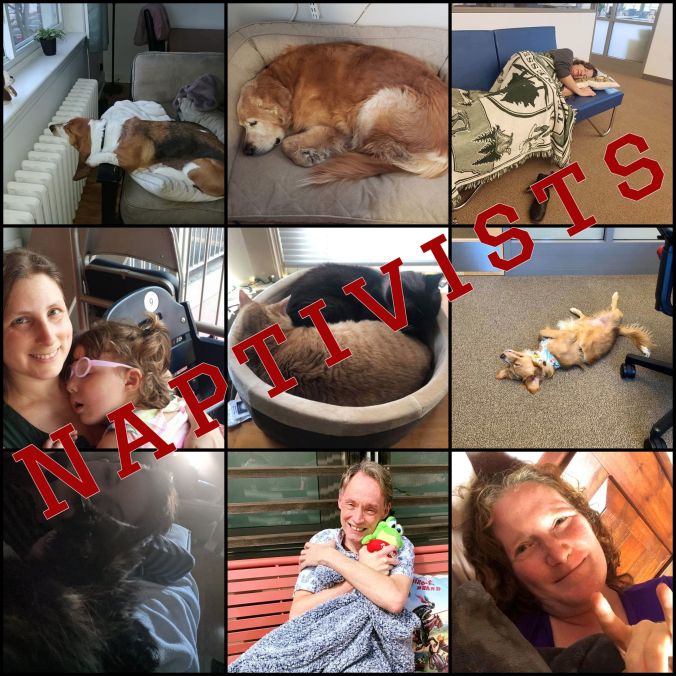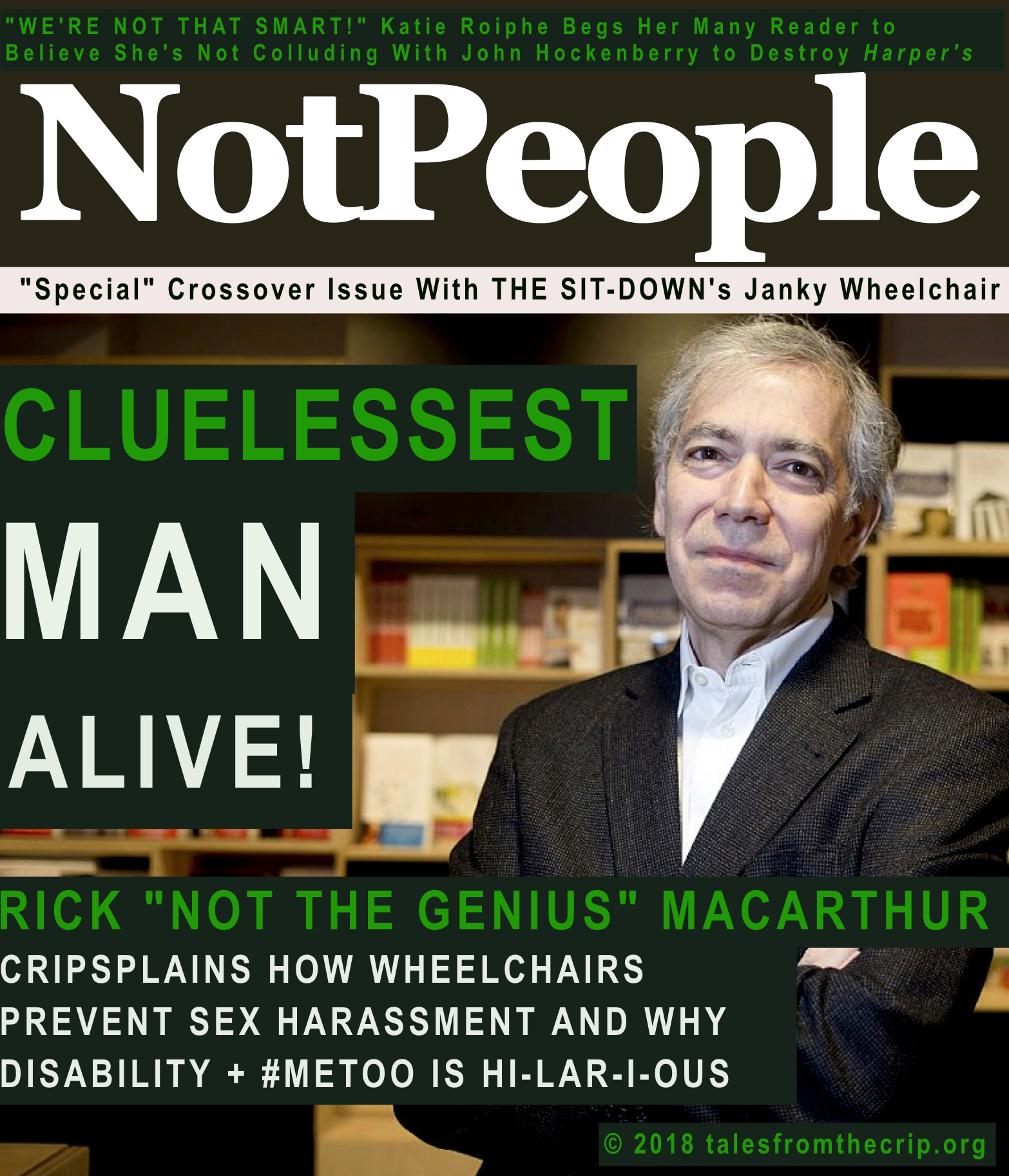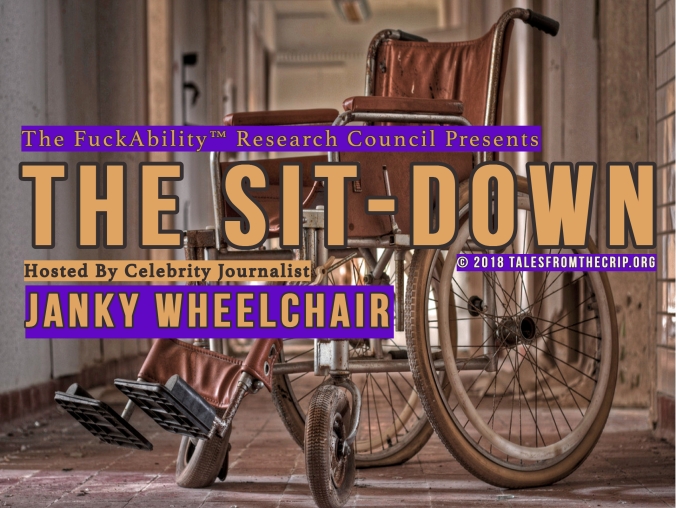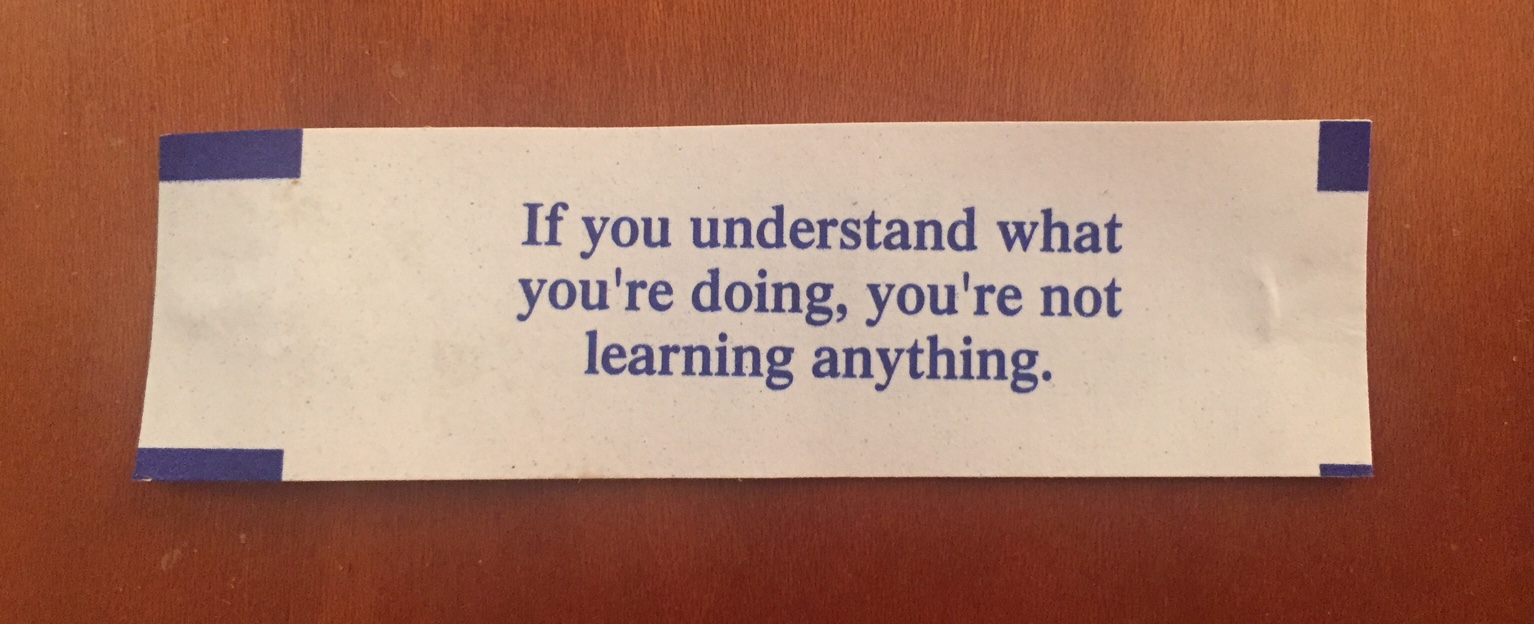Mr Ableism Proposes to Dispose of Miss Cripple Using the Sarco Death Pod
deathstyles of the rich & abled, MALE-PATTERN BS, REGENCY CRIP LIT
It is a truth universally acknowledged that a woman in possession of a neurodegenerative disease must be in want of an early death.
My dear Miss Cripple,
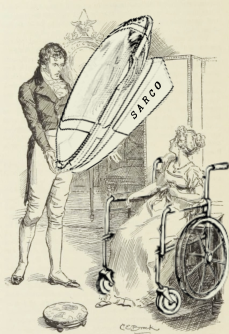
Mr Abled’s proposal so enraged her that she could only reply, “You first, sir” when he presented her with a Sarco Death Pod of betrothal.
Madam, in vain I have struggled. It will not do. My feelings will not be repressed. You must allow me to tell you how ardently I pity you and plead you to accept my assistance in hastening your death using the Sarco Death Pod on its Delicates & Gentlewomen setting.
In declaring myself thus, I am fully aware that I will be going expressly against the notion of a healthcare system that prioritizes people over profit, the rights of many people with disabilities, and, I hardly need add, my own better judgment.
But, as you may have heard, “civil rights” for unfortunates such as yourself are now largely reserved for your demise. Particularly when a gentleman such as your father has five daughters and only a small income. How may such as he afford to see your sisters wed if you and your costly care refuse to be dead? Continue reading
Crips Are Dying to Save You Money With Easy Weeknight Euthanasia Policy
deathstyles of the rich & abled, end-of-life merch
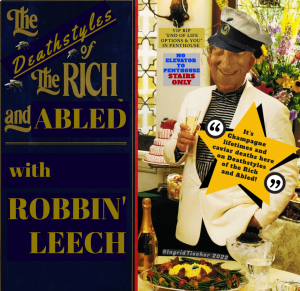 AS SEEN ON NOT DEAD YET! [Editor’s Note: The article below does cut off abruptly. While it’s true that we couldn’t afford the editing to help it continue, this in no way implies that the cut-off was anything but the article’s choice to avoid the indignity of ending “like that.”]
AS SEEN ON NOT DEAD YET! [Editor’s Note: The article below does cut off abruptly. While it’s true that we couldn’t afford the editing to help it continue, this in no way implies that the cut-off was anything but the article’s choice to avoid the indignity of ending “like that.”]
Image Description: An excerpt from one of Cost Illustrated’s articles: “Easy Weeknight Euthanasia Policy With Pomegranate and Baked Meats.” This is a satirical article about how ableist public policy and the Sarco work together. It spoofs the real magazine’s test-kitchen narrative style and format.
I Want Them to Want Me Because I Will Need Them to Need Me But If That’s Not Going to Work, I Want a Lawyer.
Every time Gretchen saw the DNR forms on her desk at home, a wave of resentment rose. How did she know what it was like to use a feeding tube? Or a ventilator? Or have minimal brain function, for god’s sake? It was like asking an eight year-old to sign up for – or against – puberty.
Choice was such bullshit. It wasn’t really her choice at all. The problem wasn’t too much extraordinary medical treatment, it was the limits of ordinary medicine to worry about, mostly financial. She didn’t have a problem being kept alive through artificial means now – she’d never seen a dollar bill push out of the dirt in spring – so she didn’t see any reason to assume she would resent it later on.
“Dear Valued Healthcare Provider,
“I’m glad everybody’s so concerned about honoring my choices. I choose to have my medical care continue regardless of ability to pay or insurance coverage, deductibles, prescription benefits, or other cost issues….”
Continue reading
Useless Eaters Don’t Get Stuck Between Life and Death With the Dysoon Void 3000 Vacuum. But Is It Better Than the Sarco Death Pod?
deathstyles of the rich & abled, end-of-life merch, male-pattern bs
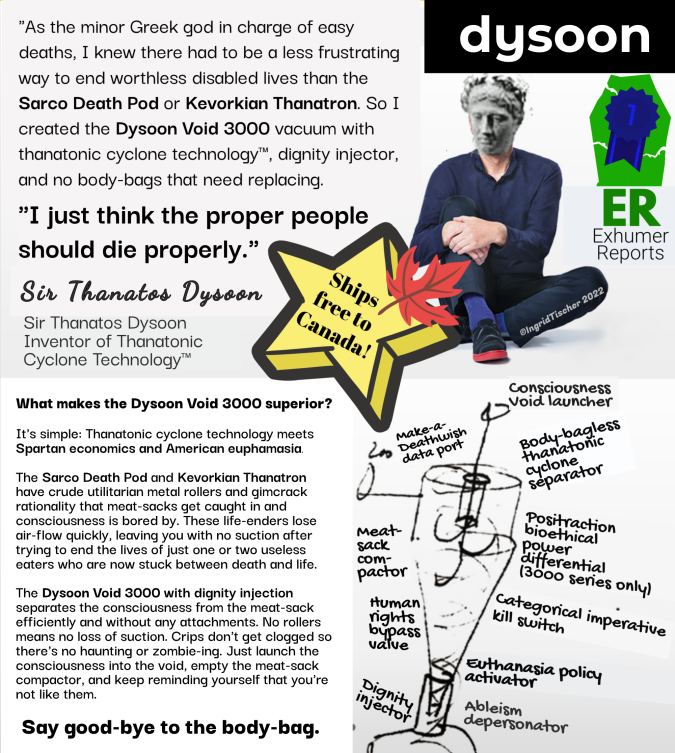
image description
Mortha Stewart Is Serving Up Romance In Philip Nitschke’s Sarco Death Pod
deathstyles of the rich & abled, end-of-life merch, male-pattern bs
“All I had left to do was reposition my newly lifeless rival in the Sarco Death Pod (now available in Careless Whisper Red) as if she were a peaceful brisket nestled in a crock-pot, and it was set-it-and-forget-it time while plausible deniability downloaded into my beloved’s shattered consciousness.”
mortha’s dark forces jan/feb 2023
a rage room of one’s own
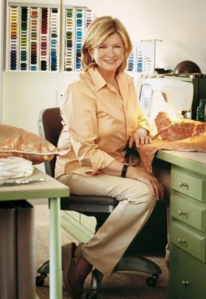 Today I’m going to teach you how Philip Nitschke’s wonderful Sarco Death Pod can remove a love rival from your life without leaving a hole that anyone will notice. There are people you so look forward to sending to hell and I want to share with you how I achieved one of my most very special triumphs. It’s a love letter, straight from my heart.
Today I’m going to teach you how Philip Nitschke’s wonderful Sarco Death Pod can remove a love rival from your life without leaving a hole that anyone will notice. There are people you so look forward to sending to hell and I want to share with you how I achieved one of my most very special triumphs. It’s a love letter, straight from my heart.
A project like this always starts in my rage room, where I do all my planning and keep all of my tools neatly organized. My favorite tool by far for eliminating the unwanted is Philip Nitschke’s Sarco Death Pod. A true multi-tasker, the Sarco can go from ending a life, to storing the body, to being server-ware that you’re proud to display your loved one in at the viewing.
I trust that the dying process inside the Sarco Death Pod is not only painless but euphoric because it’s still-animate creator, Philip Nitschke, says that it is. He knows because there is not a single negative review on Yelp from people who have used the Sarco Death Pod. Not one person has complained that their Sarco didn’t cause them to die by asphyxiation in around five minutes. Give or take a few last moments that – fingers crossed! – weren’t the mother of all nightmares in your oxygen-deprived consciousness. But you’ll look peaceful on the outside!
Continue reading
And Now a Brief Word from Josephine, the Scar That Runs All the Way Down My Back
Hey! Here in the back. ScarJo here. I’m FED UP with the lack of respect, okay?
Look, I’m a long, faintly pink line that starts just the above the shoulder blades and ends above the ass-crack. Yeah I’m real sorry about offending your delicate sensibilities. I moved in when my landlady was about 13 and had had a spinal fusion cause her scoliosis was out. of. control. Whereas I held things together.
I was a lot more colorful in those days. A lot more sensitive. Cut nerves I can handle though. But I’m supposed to accept I’m shameful? I’m not exactly blaming my landlady, who was a teenager at the time, for trying to find bathing suits and a prom dress that would hide as much of me as possible. She was a new driver still looking for an unmarked exit off the Bullshit Highway.
“Would you prefer unblemished and dead?”
Remember, all I am is a pink line, with the tiniest smidge of a ridge, on a person’s back. We’re not talking about a sucking chest wound. Or pus. Or whatever’s wrong with Steve Bannon’s complexion. I’m not asking to be a big deal, I’m not asking for attention, for cripes sakes. It’d just be nice to get out and get some freaking fresh air once in a while, you know?
But nooooooo, I’m a SCAR and I must be hidden. Continue reading
We Can’t Hold Our Breath Until Philips Respironics Takes Real Action On Its Recalled Equipment
Join Our National Call To Repair Or Replace Recalled Breathing Devices
Individuals who depend on recalled ventilators and other breathing devices manufactured by Philips Respironics have joined in a letter, along with over two dozen disability organizations, demanding that Philips repair or replace the devices. The recall was announced in June, stating that the devices were found to release potentially harmful particles and gasses, but offering little information and no timeline for corrective action.
I’m among the affected individuals and have been part of a small group of users organizing a response with the support of the New York Law School and its Civil Rights and Disability Justice Clinic. “Respiratory equipment is not like a car that’s faulty. You can stop driving the car, but you can’t just postpone breathing. So we were given a really ridiculous thing that they called a choice, which was use it or don’t,” I told The Verge.
Update: Philips announced a repair and replacement program for one of their recalled models, the DreamStation, on September 1, 2021.
Take Action
- If you are affected by the recall and want to sign on to this open letter and/or speak to the media, complete this short form.
- Share this letter with your friends and family, elected representatives, and any media outlets who may not be aware of the recall.
- If you use social media, share your experiences with hashtag #SuckYouPhilips.

This is a graphic illustration by Haley Brown with a bright cobalt blue background. There are black lungs filled with dark gray puffy clouds. In the left lung is a yellow canary bird with a red eye in a mid-flight attack pose. In the right lung there is a red circle. Around the lungs there is clear white tubing that is entwined. Above this graphic the white text reads: #SuckYouPhilips
The full text of the group’s press release follows. Continue reading
I Remember This: The Girls With the Black Bars Over Their Faces
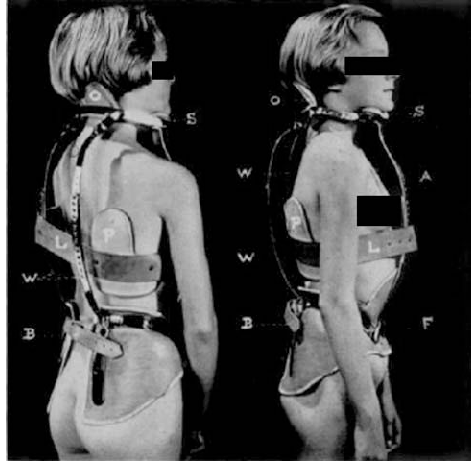
Source: researchgate.net: (Reprinted from Blount WP, Schmidt AC, Bidwell RG. Making the Milwaukee brace. J Bone Joint Surg Am. 1958;40:526–528 with permission from Journal of Bone and Joint Surgery, Inc., Needham, MA.)
1977. I am 11 years old. I am half-naked in a crowded hospital hallway.
I’ve gotten ten steps down the hall from the exam room where my mother is waiting before I fully appreciate that my fish-white thighs are fully on display.
My thighs are doing their best to walk the rest of me onward. The rest of me is wearing underpants, an all-too-sheer white t-shirt, and a Milwaukee back-brace.
The words, You are half-naked in public, explode in my mind like a bad-dream bomb.
Continue reading
#TiredOfAbleism? Calling All Naptivists to Join the 1st Nap-a-thon for Disability Rights Advocacy March 13-15, 2020
Disability rights advocacy is tough and tiring. Supporting disability rights advocates shouldn’t be. Napping as activism is an easy way to do it!
Here’s what you DO:
1. You, your kid, dog, cat, horse, or sloth companion nap anytime between 3/13-15/20 and snap of photo of you doing it. Post it on social media with #TiredOfAbleism. Include alt-text!
Here’s where you can follow the action:
On Facebook: https://www.facebook.com/events/196300241622595/
On Twitter: @IngridTischer, @DREDF
2. Post a message with your photo: “I’m napping for disability rights because I’m #TiredOfAbleism. We need to bring attention to ableism and support Disability Rights Education and Defense Fund (DREDF) in fighting discrimination. Will you give a donation in honor of my nap?”
3. Add a FB Donate button or a link to dredf.org/support-our-work/, and note “naptivism.” All donation amounts welcome!
→ Scroll down for The Top 10 Reasons Why You Should Support Naptivism for Disability Rights March 13-15, 2020
Disability media peeps! Naptivism is an example of crip-led activism and philanthropy shifting the disability narrative from:
-
“awareness” to advocacy
-
charity to social justice
-
using less accessible fundraisers to more inclusive action

This Hero Naptivist could be you on World Sleep Day, 3/13/20. Will you answer the call of naptivism for the cause of disability rights?
Long ago when I was a disabled fundraiser at Breast Cancer Action, I jokingly said sleeping was more my thing than some 3-day-schlepp for “awareness.” Yada yada, it’s the 1st annual nap-a-thon for disability rights advocacy!
I Remember This: I Am Thirteen and in the Recovery Room After Spinal Fusion Surgery
 You are flat on your back under a glaring light. The bed is hard. It hurts. You don’t move because it doesn’t occur to you to do so, it’s so far beyond you. Each part of you that registers – reports in, so to speak – registers through pain. You body is mapped as a topography of pain. No face or distinguishing characteristics. You are a ground-colored shape dotted with points of glaring, popping pain. Where your head aches on the stone-stab mattress, where the gravel of the sheet is under your arms, where it rasps all along the tube that snakes down your throat, to an unidentifiable pressure on your front, low down.
You are flat on your back under a glaring light. The bed is hard. It hurts. You don’t move because it doesn’t occur to you to do so, it’s so far beyond you. Each part of you that registers – reports in, so to speak – registers through pain. You body is mapped as a topography of pain. No face or distinguishing characteristics. You are a ground-colored shape dotted with points of glaring, popping pain. Where your head aches on the stone-stab mattress, where the gravel of the sheet is under your arms, where it rasps all along the tube that snakes down your throat, to an unidentifiable pressure on your front, low down.
Your back. Oh. Your back is a barely contained thorn patch in a mad stabber’s arsenal.
You’re not alone. There are voices, professional ones. But no one is talking to you.
There is a nurse above you, meeting your eyes. Her head blocks the light. “You’re awake,” she says. “You’re in the recovery room.”
You make a sound. It sounds dreadful. The first sound Frankenstein made on his slab. The thought of the monster brings back your past, all there was before this light, this slab, this pain. And the face in your reunion with memory itself is: Gene Wilder in Young Frankenstein.
Continue reading
And Now a Word From the FuckAbility™ Research Council on the Film The Favourite
If You Don’t Care for Satire, Beware of This Greek Director Filming Rabbits
The Verdict: The Favourite is full of shitty people, shitty behavior, and shit. It is a magnificent film about that most favored form of disability: crippling whilst posh. It centers a disabled woman fucking and then fucks with your head about disabled women fucking. So. It’s complex. It portrays a disabled woman being sexual and a jackhole. Also: I laughed. A lot.
(The 18th Century; The Court of Queen Anne But Not Really) If you took Tony Richardson’s Tom Jones, and Kubrick’s Dr. Strangelove, shoved them into Watership Down with any of John Waters’s pre-Hairspray films, the surviving film that hopped out might be Yorgos Lanthimos’ The Favourite.
Christ on a cracker, the FuckAbility™ Research Council hates being serious but needs must on the issue of casting and representation. Olivia Colman has a disability history that is, in fact, relevant to her role in The Favourite. Ruling that she’s not disabled enough, or has the wrong disabilities to qualify her for the role, reduces us to our diagnoses — something we have long fought against.
Bawdy without any ameliorating jolliness, The Favourite has an essential meatiness that’s mostly missing from the lives of bodies on the mainstream screen, including physically disabled, ill, or aging bodies. It got to me. The night after I watched it, I had a dream that I went to use the toilet and found I had shit smeared all under my clothes. When I woke up I knew it was because the reeking sensibility of The Favourite had made a powerful impression on me.
Continue reading
My FEDup™ Rant: Oh, Goody, a Debate About Whether I Should Be Allowed to Breed
I’m FEDup with “debates” about my sexuality, my reproductive choices, my existence. There is so much to love about social media and one of those reasons is the experience of going on Twitter to quickly check my popularity see what I can do to better the world and finding an objective discussion underway regarding whether someone like me should be “allowed” to reproduce. The person who asked the question may not even understand that, by placing my reproductive choices and existence within the frame of public approval, they’ve reinforced bias against me, a woman with a congenital disability who lives “like that.” Check out another guy who asks rational questions just like you did.
I’m not answering on Twitter because — unlike when I was in my 20s, 30s, 40’s — I no longer feel required to justify my existence just because somebody decided to have an “objective” “discussion” about whether I’m really worth the hassle.
Yup, even when your purpose is ostensibly positive, how you frame the conversation matters. Growing up with muscular dystrophy means I’ve heard more times than you can imagine that my particular disability places me — of course! — on The List of Lives That Suck. What’s newer or less personal to you is very different to me as a woman with a congenital disability. So here’s an excerpt from a longer past post that elucidates where I’m coming from. Continue reading
I Remember This: What Getting My First Milwaukee Backbrace Was Like
I don’t ordinarily post memoir pieces but I have written a lot of first-person material as writing exercises. I’m posting one such piece now to share a little bit about being a very young disabled child.
Because my memories go back to the age of three and no farther, it seems as if I came into existence as I was (just barely) walking with my mother, and occasionally my father, through the long hallways of Rochester’s Strong Memorial Hospital around 1969.
In the confusion about what was wrong with me — cerebral palsy atypical was their best guess and a misdiagnosis until I was 11 — it must have been a strange relief to the neurologists and orthopedists to come upon scoliosis, a particular problem, discrete and treatable.
TryHarder™ Magazine: The So You Wanna Use the R-Word for Comedic Effect Issue
 Issue No. 4: The It’s Not Just That You Used a Slur, It’s That You Doubled-Down on Your Offensive Language Edition
Issue No. 4: The It’s Not Just That You Used a Slur, It’s That You Doubled-Down on Your Offensive Language Edition
In which The Crip responds to a Daily Kos writer’s post and subsequent comments America’s Next Top Jackhole, Louis CK, who ordinarily one would have thought came from was Republican author, given the writer’s intransigence to making a change that was so easy, obvious, and respectful. would shut the fuck up, in general, and definitely about disabled people, in particular.
The Top 5 Reasons Why Everyone (Me) Knows You Never Use the R-Word in a Careless and Lazy Fashion and Also Just Don’t Use It
1. Presumably, you want people to respond to the actual topic of your article, which you’ll notice I’m not doing.
HEY! YOU! MEDIA! An Inconvenient Truth About Why Casting is a Problem in “The Upside”
The inconvenient truth about The Upside is that its misguided casting is based in a biased business decision, not creative expression.
As in Me Before You, Breathe, and He Won’t Get Far on Foot, The Upside failed to cast a wheelchair-using actor and instead chose Bryan Cranston, who does not have a visible disability. Admittedly, I hadn’t expected Cranston to have actually been “the one who knocks” in his own life when he played the role of a drug dealer. But I am critical of him deciding to take the role of a recently disabled man — and, more importantly, I’m critical of how systems protected him from having to face serious competition from wheelchair-using actors.
Cranston recently defended his choice, saying it was a “business decision.” Disabled actors make business decisions, too. But their’s are too often, “I gotta eat and pay rent so I’ve decided to give up on the business that won’t audition, much less hire, me – not even to play a disabled character.”
Cranston, and many others, scoff at disabled people’s criticism, saying that movies are a commercial venture and that, moreover, disability is just another fictional experience to portray. Actors act, after all…unless the actor has a visible disability, in which case their talent could never sway an audience — or a producer.
Muddling these arguments together is a mistake. The first is about business practices and the second is about creative expression. For actors, creative expression requires industry access — and that’s why casting norms need to change before debates about representation and creative expression can be anything but theoretical.
If the industry is going to limit nearly all physically disabled actors to roles defined by physical disability, non disabled actors shouldn’t be surprised when there’s anger at seeing those roles lost to actors who are not physically disabled. If only 2% of roles are disabled characters, to begin with, and 95% are played by actors without disabilities, that’s a systemic employment barrier.
Creative expression has different bases. Some of us experience disability as an event that affects our lives and some experience it as a component of our identity. Many of us experience both. Continue reading
An Open Letter to Advocacy Funders: #FundDisAdvocacy Because Disability + Ableism = Structural Discrimination
Want in on the conversation about ableism? Check out what disabled advocates, civil and human rights activists, and philanthropic leaders had to say at the Twitter chat on 10/12/18 about philanthropy and inclusion. Then make your voice heard at #FundDisAdvocacy.
 Foundation funding for disability advocacy dropped 23% between 2011-2015. Disabled people were the only group to see a decrease. Most funders are “aware” of disability but do they see ableism and structural discrimination? How do we make funders see disability civil and human rights as areas of actionable, urgent advocacy? A first step is recognizing disability as a constant but hidden set of variables in nearly all formulas for civil and human rights.
Foundation funding for disability advocacy dropped 23% between 2011-2015. Disabled people were the only group to see a decrease. Most funders are “aware” of disability but do they see ableism and structural discrimination? How do we make funders see disability civil and human rights as areas of actionable, urgent advocacy? A first step is recognizing disability as a constant but hidden set of variables in nearly all formulas for civil and human rights.
I’m writing to you in my capacity as a community organizer – which is another name for a social justice fundraiser.
I believe you and I share common ground on the importance of advocacy:
We know that the great civil and human rights gains of the last century, envisioned and organized by the grassroots, were built to last through the courts and legislation, and they will continue to be the battlefields for preserving them.
I’m writing because disability civil and human rights advocacy is missing from your funding portfolios.
The first step in changing that is frank communication.
When you do not explicitly say “disability” in funding advocacy, you send a message to us: Deny, disown, and downplay your disability identity. That denies all marginalized communities access to our hard-won legal tools and, worse yet, our expertise in using them.
You may understand this letter, at first, as pertaining to a discrete group: disabled people. But it is a fundamental mistake to think that civil and human rights for any community can be fully achieved if we neglect, forget, or disregard such a basic human condition as disability and allow it to be the “natural” cause of poverty and abuse. If we are not safe or free to be vulnerable, then we cannot call ourselves safe or free. Our society is not safe or free.
The NotPeople Magazine Cluelessest Man Alive Interview: Harper’s Rick MacArthur Gets Notpersonal With Janky Wheelchair About John Hockenberry, Disability, and #MeToo
He strides into the cafe we’ve agreed to meet at. Leggy, silver-tressed, with creamy skin lightly dusted with freckles, Harper’s president and publisher Rick MacArthur is a knock-out at 62 even in the rumpled khakis that glide over his still-boyish hips. When he collapses into a chair, he lays a Trapper Keeper on the table, murmuring that it’s ten times better than that [bleeped] phone nonsense.
Announcing that this is his cheat day — “I learned recently this referred to food!” — he peruses the menu — “This menu’s paper quality is fantastic, isn’t it?” — before ordering a green juice, bananas Foster, and a double Scotch. He asks me when the guy who’s doing the interview is going to show. He is adorable. He asks again, using the words, “Chop chop.” He’s everything this interview said he’d be.
I’m still mesmerized by how stunning Rick MacArthur is, in person. The Author’s Guild photos don’t do him justice. I ask who dressed him for our interview and he gazes at me with fathomless confusion before laying his fingertips lightly on his shirt-front and saying, “I should know this! He’s worked for our family since before I was born. He’s going to be so mad at me. Not that he’ll ever express it.”
As the long-awaited second installment of Tales From the Crip’s series, Imaginary Interviews With People Who We Wish Were Imaginary, our new FuckAbility™ Research Council‘s Crip Carpet Correspondent, Janky Wheelchair, follows up on TryHarder™ Magazine’s recent take-down of John Hockenberry’s journaling essay, “Exile,” by devoting an entire episode of THE SIT-DOWN to publisher of the essay, Harper’s Rick MacArthur.
The vivacious magnate talks nonstop about why paraplegics can’t sexually harass anyone; why he, a Francophile, is launching a Moi Aussi men’s movement to counter Me Too’s “Soviet-style” excesses; why paper is the future of Harper’s; and how everyone forgets how great John Hockenberry was in the film Coming Home. Keep reading for the unedited transcript of Janky Wheelchair’s exclusive hard-hitting interview with lively minx Rick MacArthur.
Flambee your bananas and keep the Scotch flowing because Harper’s RICK MACARTHUR is gracing the cover of NotPeople magazine as the CLUELESSEST MAN ALIVE!
#WSPD2019: Suicide Is a Problem, Not a Solution for Living With a Disability. Yup, Even One That’s Neuromuscular, Progressive, and Degenerative
2018 2019 UPDATE: STILL ALIVE
STILL OPPOSED TO EUPHEMIZING DISABLED PEOPLE BY NORMALIZING OUR SUICIDES THROUGH LANGUAGE
I’m still disabled, still degenerating, and still filled with joie de crip, but even if I weren’t, I still wouldn’t be buying the double-speak that calls my suicide “a rational choice,” “death with dignity,” and “ending my life on my own terms,” while a (seemingly) nondisabled person’s suicide is “a public health problem.”
The terms we use in talking about an issue set the terms of the debate. Suicide is a public health problem. Distorting that through sophistry marketing language feeds suicide contagion.
September 10 is World Suicide Prevention Day. But for a disabled person like me, it’s just not my day. Literally.
Increasingly:
What would be a “threat of self-harm” for you, is a “personal choice” for me.
What calls for an intervention for you, calls for a pre-suicide party for me.
Your movie is It’s a Wonderful Life. My movie is It’s a Wonderful Death.
When it comes to people like me, suicide is rapidly becoming normalized. Or more exactly, suicide is being erased through re-branding. “It’s not ‘suicide’! It’s ‘ending your life on your own terms’!”
But I want a great pre-end of life. I want to live on my own terms.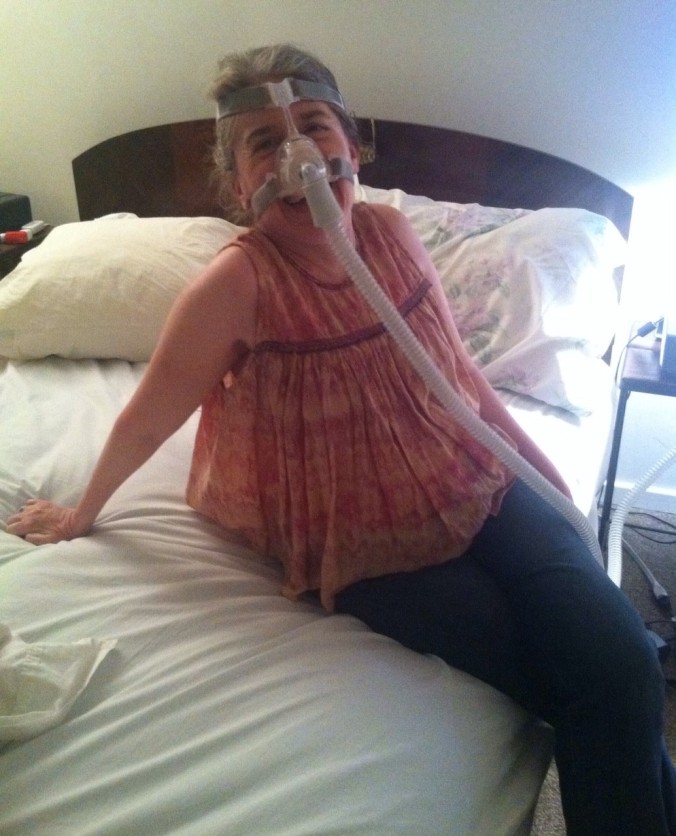
My FEDup™Rant: I Want to Be Envied
 I’m FEDup with aiming way too low.
I’m FEDup with aiming way too low.
I realized this after Congress voted this week to deny me the pleasure of peeing like non-disabled people do, which is to say, without having to do any kind of math, scheduling, or general advance planning when going out to public places.
But by being denied the minimum, I’ve learned to want everything.
You know what would be great? If I could be envied by non-disabled people.
Yes – envy’s bad! I shouldn’t want to be envied. I should want inclusion. Justice. Equality. I should want respect, love, acceptance.
Of course I want all that. But I want more.
I want to be envied by non-disabled people. Not admired. Envied.
Continue reading
Top 10 Reasons Why Focusing on White Students With Disabilities Is Not Acceptable Policy Strategy. In DC or Anywhere.

I used this very same image for another post and darned if it isn’t perfect for this one, too! Courtesy Fox.
10. Because it’s racist. (In a rush? You can stop here!)
9. Because education policy is entwined with juvenile justice and incarceration policies for students of color with disabilities and, funny thing, disabled advocates of color think those issues are kind of urgent.
8. Because we lack the nanotechnology to measure the moral integrity of erasing students of color with disabilities from the very issue that derails and destroys their lives in vastly disproportionate numbers.
Continue reading
This Crip Stays in the Picture: A Past Plaintiff on Opposing H.R. 620, the ADA Notification Act

This crip is staying in the picture of ADA litigation.
I’m Ingrid Tischer. You may remember me as “headless female torso using a walker” from Anderson Cooper’s “ADA Hit-Piece of Horror” on 60 Minutes. But I’m here today to tell you about a different type of horror: Being a plaintiff in an Americans with Disabilities Act (ADA) lawsuit, in which you’re presumed greedy and where whatever happened to you was no more than an inconvenience.
Four years ago, I began a multi-year metamorphosis into “non-vexatious litigant wanting to use a toilet.” That makes me the face of ADA lawsuits. But, in the 60 Minutes segment and the continuing slew of hand-wringing pieces about ADA scam-artists, you don’t see any faces like mine. A face like mine disrupts the narrative of the selfish — or gullible — cripple who financially kneecaps overwhelmed small business owners over access technicalities. You don’t hear much about how the proposed H.R. 620 would also apply to our considerably larger corporate citizens. So I’m putting my face right out there. This crip stays in the picture.
Despite the media’s fixation on “drive-by litigation,” — a completely non-accidental choice of phrase that associates fighting for my civil rights with gang violence – I was using the ADA as it was intended to be used, and should be used. As a civil rights law that, in 1990, made me a full US citizen at the age of 25. But in addition to the external changes in public spaces that have literally opened doors for me, the ADA is responsible for a profound internal shift in my thinking: I have expectations now that I didn’t grow up with: that I can enter a store, eat at a restaurant, cross a city street, open my office door.
The Crip Sense: “I See Women and Girls With Disabilities. In Your Organizations.”
In my particular line of work — fundraising — I have the “challenge” of making the case for funding cross-disability civil rights work from institutional funders who are still predominately stuck in the disability = tragedy trope.
I need allies from outside the cross-disability communities because that’s how philanthropy — and everything else — works: it’s who you have relationships with, who you can ask for help, give help to.
I was really excited about closing out Women’s History Month this year by developing and delivering an interactive workshop, “Building Your Organization’s Capacity to Ally With Girls Who Have Disabilities: Principles to Practices” for fellow (sister?) Alliance for Girls members, as part of my work at DREDF. (To the members who attended — you were GREAT participants!) Based on issues I’d recently written about, I wanted to call it “The Crip Sense or ‘I See Women and Girls With Disabilities. In Your Organizations.’” (Scroll down for 3 “posters” of workshop content.)
I said that part of having The Crip Sense is seeing things that are painful:
- Disability human and civil rights violations. Way too many of them.
- Violence against disabled children and adults – especially people of color (PoC) with invisible disabilities — even by caregivers, school personnel, and law enforcement officers, and that such violence at home, in school, and on the street is excused or rationalized.
- Girls who have internalized stigma that makes it feel “normal” to disown, downplay, or deny having a disability.
- Girls who hear – even from some disabled people – that “initiative” and “personal responsibility” can defeat systemic barriers born of — and well-maintained by — prejudice, and that they’ve failed if they’re defeated by rigged systems.
Why This Workshop, Why Now
In 2017, an inclusive movement includes cross-disability civil rights organizations, as a given.
Before I Resist and Persist, I Must Exist: Bioethical Choice, Living “Like That,” and Working the Early Shift of Cleaning Up Ableist Narratives
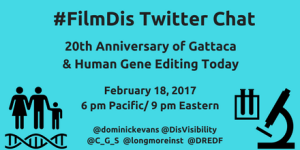 I represented DREDF in this conversation but it’s stirred up a big case of the feels about “choice” and being a liberal woman writer with a congenital disability, and the context this establishes for storytelling, and resisting and persisting. I continue, after 30 years of adult activism, to feel like I have an early shift of ableism — prepping the world to accept that I exist — while my nondisabled fellow human resisters and persisters get to sleep in. And if I weren’t white, conventionally educated, cis gendered, unthreateningly queer, and had all sorts of middle-class, married advantages, I’d probably never sleep at all. Image courtesy of the Disability Visibility Project.
I represented DREDF in this conversation but it’s stirred up a big case of the feels about “choice” and being a liberal woman writer with a congenital disability, and the context this establishes for storytelling, and resisting and persisting. I continue, after 30 years of adult activism, to feel like I have an early shift of ableism — prepping the world to accept that I exist — while my nondisabled fellow human resisters and persisters get to sleep in. And if I weren’t white, conventionally educated, cis gendered, unthreateningly queer, and had all sorts of middle-class, married advantages, I’d probably never sleep at all. Image courtesy of the Disability Visibility Project.
Step 1: I Exist!
As many people who know me know — all too well — I’ve been writing a novel* for the past 400 years or so. The novel, The Cure for Gretchen Lowe, is the exploration of a what-if premise: What if a congenitally disabled woman were offered an experimental therapy that would cure her? The cure itself, Genetic Reparative Therapy (GRT), was never the point of the story because biomedical research, real or invented, never seemed like the most interesting part of the story. What I’ve been stuck on, like an oyster (or barnacle), since the idea first irritated my imagination was how I saw that my character’s situation began as a will-she-or-won’t-she question. From what I’ve observed in 50+ years of congenitally disabled life, that question isn’t typically a question to The Average Reader. “Well, of course a person like that would want GRT!”
I’ve considered that point of view quite a bit — 400 years allows for that — and much more seriously than I make it sound here. But that assumption also irritated me mightily: As a lifelong like-that-ter, I’ve run up against a lot of nonconsensual of-coursing when it comes to my bioethical choices. Simply opening my story — which I refer to as being “CripLit” — with a genuine choice, not a pro forma one, felt like I wrote in letters across the sky: I EXIST.
My FEDup ™Rant: RespectAbility, Class and Race Privilege, and Leveling the Erring Field
I’m FEDup with transactional philanthropy that presumes disrespectful behavior can be overlooked if the price is right.
I have now been witness to: RespectAbility’s President, Jennifer Laszlo Mizrahi making a mistake; the unpleased reactions by disabled women of color; some thoughtful initial responses; Mizrahi’s cringe-worthy apology-type product; the official statement; and now (I’m guessing), The Great Moving On from uncomfortable conversations about ableism, racism, and disabled people of color within the disability rights community. [2018 UPDATE: Moving on didn’t work out so great.]
Part of me — the part that’s still polite to boundary-busting missionaries who ring my doorbell — initially wanted to say, “I’ve done this kind of racist shit myself. Sadly.” Then I remembered that much of that shit was when I was near the start of my career 25 years ago. When I would have lost my job — and Bi-Pap-providing health insurance — if I kept that shit up in our very progressive free clinic for gyn care. And how I had no safety net if I lost that job.
Everyone makes mistakes but the erring field is far from equal.
Depending on your class, Repercussions, Consequences, & Accountability are either the Three Furies that dog you even when you haven’t screwed up, or they’re the crisis PR firm you consider for damage control.
When you’re poor, unemployed, a woman, a person of color, a disabled person, or all or most of the above, making mistakes is far more likely to lead to words like “unqualified.” You are threatened with unemployment, fired, and/or are cut off from public benefits. In the worst case scenario, you haven’t made a mistake at all but are questioned, blamed, violated, beaten, shot, killed for being the person you are in public, in school, on the road, and at home.
When you’re affluent or “comfortable,” employed, a man, white, not disabled, or all or most of the above, making mistakes is more likely to lead to words like “executive coaching,” and “Let’s bring our communications person in to help.” In the worst case scenario, you “transition out” to what is often a better-paid job, aka “failing up.” If you are in a position to be a volunteer who has significant authority, the usual checks and balances on your behavior can be even weaker.
That’s when I first realized how integral money, class privilege, and power are to this recent incident. I haven’t seen any real repercussions, consequences, or accountability for Mizrahi — except for a bump to her prestige — and that’s just one infuriating aspect of how race and class insulate those with power.
Then I reread the official statement and I hit a whole new level of disturbed.
There’s an odd segue from mentioning a nonspecific action plan to the information that Mizrahi gives to many worthy causes.
“…It takes a deliberate action plan, education and implementation.
“Outside of RespectAbility, I donate to many worthy causes….”
Translation: “Giving money is a transactional arrangement for me; it’s either outright proof that I’m a good person or at least suitable cover when my behavior is criticized as racist.”
You can’t buy back respect. That’s not philanthropy.
Not even when you’ve laid claim to the word “respect” in the name of your organization. This is one place where class privilege hopes so very much to neutralize racism.
Understanding and dismantling my own race and class privilege is a lifetime of work. Being required to clean up my repeated failures was how I learned to act on — rather than merely speak of — these precepts:
- Transparent processes and equitable systems are far more trustworthy than promises made by an individual.
- Women of color do not exist to teach white women how not to be racist.
- Vague reassurances about doing better do not qualify as “accountability.”
Picture it: 1994-ish, the dilapidated second-floor gyn clinic, up from an iron-gated door open during clinic hours to the Upper Haight, San Francisco. A bunch of us staff are in the shabby waiting room with the furniture that will, at one point, give some of us scabies. It’s Wednesday morning, 10:30 or thereabouts, and the gate is closed because we’re having our weekly staff meeting.
 As we do every blessed week, we’re doing some kind of diversity exercise.
As we do every blessed week, we’re doing some kind of diversity exercise.
Everyone takes a turn, everyone complains.
Nobody gets out of it.
Everyone is deeply offended and affirmed at some point.
It was during one of those weeks that I got religion, disability-rights-wise, and that was liberating but lonely because I was the only one crip who was out. It was where I became visible to myself and then to others. But it was the example of the women of color and/or queer women who showed me how to show up. I had to follow before I could lead.
Our Director had talked our CEO into funding a 2-year Diversity Specialist consultant who will work with our whole staff. Our goal was to improve our healthcare delivery for a diverse group of women. The weeks when she is with us are rough and there are relationships that are strained and sore afterward.
We do it. We keep doing it after the funding is gone. We bake what we’ve figured out into clinic procedures, position qualifications. It’s not about us individuals, our emotional reactions, anymore. We went beyond ourselves to build a better system.
We did what we could to level the erring field without limiting the heavy labor to the women of color who were involved.
Given that Mizrahi may be Too Big To Fail, here’s my (unsolicited) action plan for RespectAbility:
- Do not put Mizrahi in charge of the action plan.
- Do not put Mizrahi on the team in charge of the action plan.
- Accept that Mizrahi’s leadership position is another ethical hazard waiting to happen, and could be in conflict with the mission of the organization. (When reducing disability stigma and advancing employment best practices are part of your mission, your President’s ableist statements and expectation of unpaid labor from women of color with disabilities constitute conflicts.)
Yup, that’s the plan. You’re the board. Figure out the action plan for the organization.
Too drastic? Way harsh?
This is awkward necessary to say: Mizrahi is an affluent white woman executive whose manner in asking for help was that of someone Summoning The Help. The very people she had just offended. And when disabled women of color didn’t come a’runnin’, she was publicly resentful. That behavior was out of bounds.
Again:
- It is not the job of women of color with disabilities to educate a white, affluent executive with a disability about racism.
- If it is a job for women of color with disabilities, pay them for it. Budget for it.
- If it’s not a job, then be honest and admit it’s not a serious commitment.
In 2016, How To Relate To People Who Don’t Look Like You is an essential qualification for any job — paid or unpaid — in disability rights. Period. If you’re not prepared, it’s on you to get prepared.
It’s not quick or easy to truly understand intersectional oppression, nor does it make you perfect. It makes you a better imperfect person. I know because I was willing to do the work.
So. Get to work.
#WSPD2016: Suicide Is a Problem, Not a Solution for Living With a Disability. Yup, Even One That’s Neuromuscular, Progressive, and Degenerative
September 10 is World Suicide Prevention Day. But for a disabled person like me, it’s just not my day.
Increasingly:
What would be a “threat of self-harm” for you, is a “personal choice” for me.
What calls for an intervention for you, calls for a pre-suicide party for me.
Your movie is It’s a Wonderful Life. My movie is It’s a Wonderful Death.
When it comes to people like me, suicide is rapidly becoming normalized. Or more exactly, suicide is being erased through re-branding. “It’s not ‘suicide’! It’s ‘ending your life on your own terms’!”
But I want a great pre-end of life. I want to live on my own terms.
#CripTheVote: You Have Hillary Clinton to Blame for This Blog Post
For the first time in my 50 years on July 28, 2016, I heard my disabled childhood described through the civil rights lens by a presidential candidate, Hillary Clinton. She centered my childhood where I would have: on education and public schools.
It’s difficult to explain the magnitude of hearing my disability identity described in the language of equal rights and not special needs. As meaningful as it was to see a woman accepting the nomination, the tectonic shift I felt was in Clinton accepting me as I am: as a person who deserves respect and can serve the greater good. Not as a diagnosis who has nothing to give or a vote to cast. Certainly not as a target to mock whose vote is irrelevant. Because I have gained my right to an education, I gladly accept the responsibility that comes with answering these two questions:
What do I want to contribute to that is bigger than myself? What is it that I have to contribute?
In using the education that Hillary Clinton and other disability rights advocates fought for, I have a shot at becoming a role model who works together with others rather than being labeled an “inspiration” who is kept at a distance.
The story of childhood is the story of education. The access to and quality of education determines whether that story is one you want to retell over and over, or one that threatens to scare you into silence. The school-to-prison pipeline and the violence that students of color with disabilities experience in the name of “discipline” are the education issues that need urgent action today. I appreciate Clinton’s past work because I see potential in it for protecting the rights of more children and youth with disabilities.
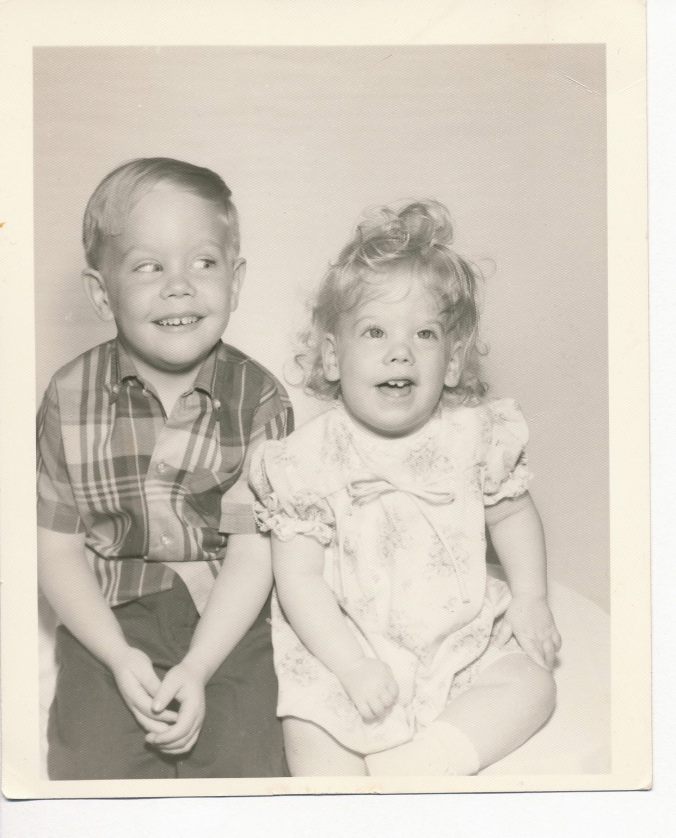
The author and her older brother. Hillary Clinton said, “Every kid with a disability has the right to go to school.” That was an idea – not the law – in 1967 when this photo was taken. Three years later, this little girl could not start first grade at the neighborhood school where her older brother went. The school had a pet rabbit named Pugsly. Inclusion: DENIED. An education: DENIED. A bunny to pet: DENIED.

